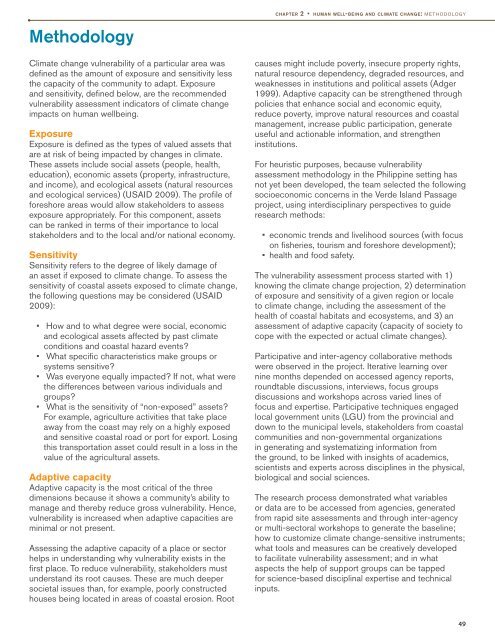of the Verde Island Passage, Philippines - weADAPT
of the Verde Island Passage, Philippines - weADAPT
of the Verde Island Passage, Philippines - weADAPT
You also want an ePaper? Increase the reach of your titles
YUMPU automatically turns print PDFs into web optimized ePapers that Google loves.
Methodology<br />
Climate change vulnerability <strong>of</strong> a particular area was<br />
defined as <strong>the</strong> amount <strong>of</strong> exposure and sensitivity less<br />
<strong>the</strong> capacity <strong>of</strong> <strong>the</strong> community to adapt. Exposure<br />
and sensitivity, defined below, are <strong>the</strong> recommended<br />
vulnerability assessment indicators <strong>of</strong> climate change<br />
impacts on human wellbeing.<br />
Exposure<br />
Exposure is defined as <strong>the</strong> types <strong>of</strong> valued assets that<br />
are at risk <strong>of</strong> being impacted by changes in climate.<br />
These assets include social assets (people, health,<br />
education), economic assets (property, infrastructure,<br />
and income), and ecological assets (natural resources<br />
and ecological services) (USAID 2009). The pr<strong>of</strong>ile <strong>of</strong><br />
foreshore areas would allow stakeholders to assess<br />
exposure appropriately. For this component, assets<br />
can be ranked in terms <strong>of</strong> <strong>the</strong>ir importance to local<br />
stakeholders and to <strong>the</strong> local and/or national economy.<br />
Sensitivity<br />
Sensitivity refers to <strong>the</strong> degree <strong>of</strong> likely damage <strong>of</strong><br />
an asset if exposed to climate change. To assess <strong>the</strong><br />
sensitivity <strong>of</strong> coastal assets exposed to climate change,<br />
<strong>the</strong> following questions may be considered (USAID<br />
2009):<br />
• How and to what degree were social, economic<br />
and ecological assets affected by past climate<br />
conditions and coastal hazard events<br />
• What specific characteristics make groups or<br />
systems sensitive<br />
• Was everyone equally impacted If not, what were<br />
<strong>the</strong> differences between various individuals and<br />
groups<br />
• What is <strong>the</strong> sensitivity <strong>of</strong> “non-exposed” assets<br />
For example, agriculture activities that take place<br />
away from <strong>the</strong> coast may rely on a highly exposed<br />
and sensitive coastal road or port for export. Losing<br />
this transportation asset could result in a loss in <strong>the</strong><br />
value <strong>of</strong> <strong>the</strong> agricultural assets.<br />
Adaptive capacity<br />
Adaptive capacity is <strong>the</strong> most critical <strong>of</strong> <strong>the</strong> three<br />
dimensions because it shows a community’s ability to<br />
manage and <strong>the</strong>reby reduce gross vulnerability. Hence,<br />
vulnerability is increased when adaptive capacities are<br />
minimal or not present.<br />
Assessing <strong>the</strong> adaptive capacity <strong>of</strong> a place or sector<br />
helps in understanding why vulnerability exists in <strong>the</strong><br />
first place. To reduce vulnerability, stakeholders must<br />
understand its root causes. These are much deeper<br />
societal issues than, for example, poorly constructed<br />
houses being located in areas <strong>of</strong> coastal erosion. Root<br />
chapter 2 • human well-being and climate change: methodology<br />
causes might include poverty, insecure property rights,<br />
natural resource dependency, degraded resources, and<br />
weaknesses in institutions and political assets (Adger<br />
1999). Adaptive capacity can be streng<strong>the</strong>ned through<br />
policies that enhance social and economic equity,<br />
reduce poverty, improve natural resources and coastal<br />
management, increase public participation, generate<br />
useful and actionable information, and streng<strong>the</strong>n<br />
institutions.<br />
For heuristic purposes, because vulnerability<br />
assessment methodology in <strong>the</strong> Philippine setting has<br />
not yet been developed, <strong>the</strong> team selected <strong>the</strong> following<br />
socioeconomic concerns in <strong>the</strong> <strong>Verde</strong> <strong>Island</strong> <strong>Passage</strong><br />
project, using interdisciplinary perspectives to guide<br />
research methods:<br />
• economic trends and livelihood sources (with focus<br />
on fisheries, tourism and foreshore development);<br />
• health and food safety.<br />
The vulnerability assessment process started with 1)<br />
knowing <strong>the</strong> climate change projection, 2) determination<br />
<strong>of</strong> exposure and sensitivity <strong>of</strong> a given region or locale<br />
to climate change, including <strong>the</strong> assessment <strong>of</strong> <strong>the</strong><br />
health <strong>of</strong> coastal habitats and ecosystems, and 3) an<br />
assessment <strong>of</strong> adaptive capacity (capacity <strong>of</strong> society to<br />
cope with <strong>the</strong> expected or actual climate changes).<br />
Participative and inter-agency collaborative methods<br />
were observed in <strong>the</strong> project. Iterative learning over<br />
nine months depended on accessed agency reports,<br />
roundtable discussions, interviews, focus groups<br />
discussions and workshops across varied lines <strong>of</strong><br />
focus and expertise. Participative techniques engaged<br />
local government units (LGU) from <strong>the</strong> provincial and<br />
down to <strong>the</strong> municipal levels, stakeholders from coastal<br />
communities and non-governmental organizations<br />
in generating and systematizing information from<br />
<strong>the</strong> ground, to be linked with insights <strong>of</strong> academics,<br />
scientists and experts across disciplines in <strong>the</strong> physical,<br />
biological and social sciences.<br />
The research process demonstrated what variables<br />
or data are to be accessed from agencies, generated<br />
from rapid site assessments and through inter-agency<br />
or multi-sectoral workshops to generate <strong>the</strong> baseline;<br />
how to customize climate change-sensitive instruments;<br />
what tools and measures can be creatively developed<br />
to facilitate vulnerability assessment; and in what<br />
aspects <strong>the</strong> help <strong>of</strong> support groups can be tapped<br />
for science-based disciplinal expertise and technical<br />
inputs.<br />
49
















